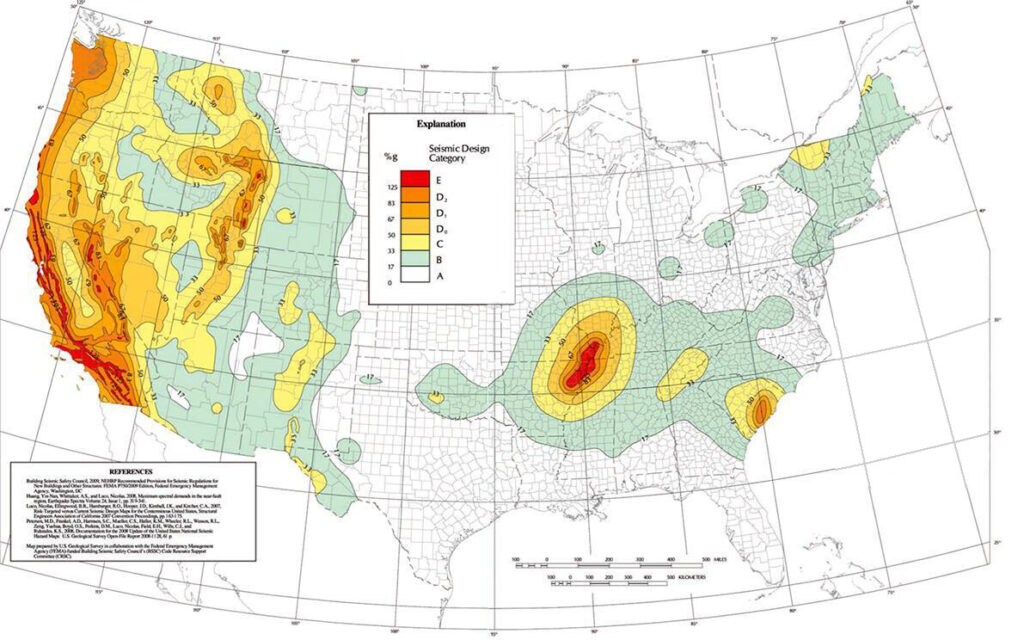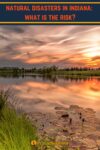Nearly 6 million people live in Indiana. Many of these people have experienced natural disasters in the state firsthand or had to evacuate because of disasters. However, many Indiana residents don’t realize just how many types of natural disasters can occur in the state.
This analysis goes over what natural disasters occur in Indiana, the worst natural disasters to hit the state since 2000, and what residents can do to prepare.
Is Indiana At Risk of Natural Disasters?
Compared to the rest of the United States, Indiana has a low risk of natural disasters. Excluding COVID, Indiana has had 23 disaster declarations since 2000. Of these, 19 were declared major disasters.
Indiana is also frequently hit by natural disasters, which cause more than $1 billion in damages. Since 2000, Indiana has been affected by 65 separate $1-billion events. Most of these were severe storms. Because Indiana is an agricultural state, heat waves and droughts can be particularly costly.
Worst Natural Disasters in Indiana By Cost (Since 2000)
- Hurricane Ike 2008: $40.8 billion
- 2012 US Drought and Heat Wave: $39.3 billion
- Spring-Summer 2011 Drought and Heat Wave: $16.2 billion
- Spring-Fall 2002 Drought: $15.1 billion
- Midwest Flooding 2008: $14 billion
Worst Natural Disasters in Indiana By Deaths (Since 2000)
- May 2011 Tornado Outbreak: 177 deaths
- 2012 Drought and Heat Wave: 123 deaths
- Hurricane Ike 2008: 112 deaths
- Spring-Summer 2011 Drought and Heat Wave: 95 deaths
- December 2021 Tornado Outbreak: 93 deaths
*Cost and death tolls are for the entire disaster, including in other states affected.
Most Common Natural Disasters in Indiana
1. Flooding
Many parts of Indiana are at high risk for flood disasters. Floods often occur in the state because snowmelt and heavy rainfalls overrun rivers or fill the large, flat areas of the state. Flash flooding can also occur during thunderstorms.
Approximately 8% of all properties in Indiana are at substantial risk of flooding and 11% of properties in Indianapolis are at risk. Because of climate change, the risk of flooding is increasing in many areas of Indiana.
Indiana Flood Stats
- 282,000 properties at substantial risk in 2020
- 34,124 properties in Indianapolis at risk of flooding in 2020
- 158,300 FEMA flood damage claims since 2000
- 440,800 properties will be at risk by 2050
- 73,100 properties at almost certain risk by 2050
Which Areas of Indiana Are Most At-Risk to Flooding?
In some areas of Indiana, a huge percentage of properties are at risk of flooding. Below are the areas of Indiana which have the greatest percentage of properties which were likely to experience flooding (based on 2020 calculations).
- Peru: 81%
- Logansport: 51%
- East Chicago: 48%
- Aurora: 40%
- Dyer: 38%
- Munster: 37%
- Tipton: 36%
- Portland: 35%
Worst Flood Events in Indiana’s Recent History
The worst flood event to hit Indiana in recent times was the June 2008 flood. The flood affected 54 of Indiana’s 92 counties.
The city of Columbus was hit particularly badly and completely surrounded by water for almost an entire day. At least 3 people died and 25,000 people were affected by the disaster.
The flood caused an estimated $126 to $1 billion in damages and affected 9% of farmland in the state.
Indiana has also had many other severe floods. Since 2000, Indiana had one major disaster declaration due to flooding and has been affected by 5 separate billion-dollar flood events. There have also been many smaller events in the state, including flash floods with fatalities.
2. Earthquakes
Indiana is located in the New Madrid Seismic Zone (NMSZ). While this zone doesn’t have earthquakes as frequently as those in the Western part of the USA, it has the potential for very large, damaging events of up to magnitude 7.6.
The NMSZ has approximately 200 earthquakes each year. Most of these are too small to be felt. However, there is an earthquake of magnitude 4.0 or greater in the zone approximately once every 18 months. A magnitude 5.0 quake occurs approximately once every 10 years.
The southwestern part of Indiana is particularly at-risk for damaging earthquakes, but quakes could affect anywhere in the state.
One of the worst earthquakes to occur in Indiana was a magnitude 5.1 earthquake in 1909 in the Wabash River valley. Indiana can expect a magnitude 4.0 quake about once every 12 years.

3. Tornados
Indiana only averages 28 tornadoes per year.
While the state has never had an F5 tornado, it has had F4 tornadoes and many F3 tornadoes. These tornadoes can cause massive amounts of property damage.
Since 2000, there have been 41 tornado-related fatalities in the state. Because of how much damage they cause, Indiana ranks #4 in the USA in terms of tornado risk.
4. Heavy Snowfall and Winter Storms
Indiana has an average of nearly 22 inches of snowfall each year, which ranks it towards the middle in terms of snowfall by state. However, this number is a bit deceiving because it averages the state as a whole.
The northern part of Indiana, especially near the Great Lakes, receives much more snowfall than the central and southern parts of the state.
South Bend, for example, has an average snowfall of 64.5″ per year. The most snow South Bend has ever received in a single day was 26 inches in 2011.
Heavy snowfalls and winter storms do occur in Indiana. One of the worst on record was the blizzard of 1978. Winds received 50mph and snowfall up to 1 inch per hour. Indianapolis was buried under 15.5 inches of snow and brought to a standstill.
Indiana Winter Weather Stats
- Average snowfall per year: 21.93″
- Snowfall days per year: 25.54 days
- Coldest recorded temperature: -36F in New Whiteland in 1994
- Record snowfall: 44.5″ in 1979
5. Freezing Rain
The climate of the Midwest makes it ideal for freezing rain. Indiana doesn’t have freezing rain as frequently as states in the Northeast, but freeze events do occur. Most parts of Indiana can expect at least 9-12 hours of freezing rain per year. Some regions can get up to 15 hours.
Freezing rain most frequently occurs during December and January, but fall and spring freeze events also occur.
Icy road conditions from the rain make vehicle accidents and slip-and-fall injuries common. It’s also common for people to lose power during freezing rain events, meaning that thousands can be left without a way to heat their homes during the coldest months.
Read:
6. Heat Waves and Drought
Indiana is part of the “Extreme Heat Belt” in the central United States. This region is very at risk of what the National Weather Service calls “dangerous” and “extremely dangerous” heat days.
A “dangerous” heat day is defined as one where the heat index is 103F, and an “extremely dangerous” day has a heat index of 124F or above, which is considered unsafe for all people for any amount of time.
By 2053, an estimated 107 million people in the Extreme Heat Belt will be affected by Extreme Danger days. In Indiana, more than 300,000 are considered vulnerable to extreme heat.
The risk of dangerous heat days is expected to increase throughout all parts of Indiana. Posey is one of the most at-risk counties in the state. In 2022, Posey had an average of 27 dangerous heat days. By 2053, this number will increase to 46 days.
Heat waves are often accompanied by droughts. Because Indiana is an agricultural state, droughts can be particularly devastating for farmers.
https://www.epa.gov/climate-indicators/climate-change-indicators-heat-waves
https://www.c2es.org/content/heat-waves-and-climate-change/
https://worldpopulationreview.com/state-rankings/average-snowfall-by-state
http://www.usa.com/rank/us–average-snow–state-rank.htm
http://www.usa.com/rank/us–average-snow-days–state-rank.htm
https://clearsurance.com/blog/states-with-most-fatal-winter-crashes
https://www.moneygeek.com/insurance/auto/analysis/worst-states-winter-driving/
https://www.currentresults.com/Weather-Extremes/US/snowiest-day.php
https://www.infoplease.com/math-science/weather/record-lowest-temperatures-by-state
https://www.discovermagazine.com/environment/welcome-to-hail-alley-a-u-s-region-prone-to-pelting-ice
https://www.moneygeek.com/insurance/homeowners/analysis/top-states-for-hail-losses/
https://wgntv.com/weather/weather-blog/where-does-hail-occur-most-often-in-the-united-states/
https://stacker.com/weather/states-most-hailstorms
https://www.verisk.com/insurance/capabilities/weather-risk https://www.iii.org/fact-statistic/facts-statistics-wildfires
https://www.globalforestwatch.org/dashboards/country/USA/11/119
https://www.verisk.com/
https://www.moneygeek.com/insurance/homeowners/analysis/wildfire-statistics/#wildfires-by-state
https://www.geographyrealm.com/geography-hail-united-states/
https://www.weather.gov/media/safety/59-16_State_Ltg_Fatality%2BFatality_Rate_Maps.pdf
https://www.livescience.com/14714-lightning-prone-states-110620.html
https://www.statista.com/statistics/1292499/leading-states-by-total-lightning-count-us/
https://www.earthnetworks.com/blog/states-most-lightning-strikes/
https://www.worldatlas.com/articles/the-five-most-lightning-prone-states-in-the-united-states.html
https://www.moneygeek.com/insurance/homeowners/analysis/top-states-for-hurricane-losses/
https://www.statista.com/statistics/1269483/number-of-hurricanes-that-made-landfall-in-the-us-state/
https://coast.noaa.gov/states
https://assets.firststreet.org/uploads/2020/06/first_street_foundation__first_national_flood_risk_assessment.pdf
https://floodlist.com/


